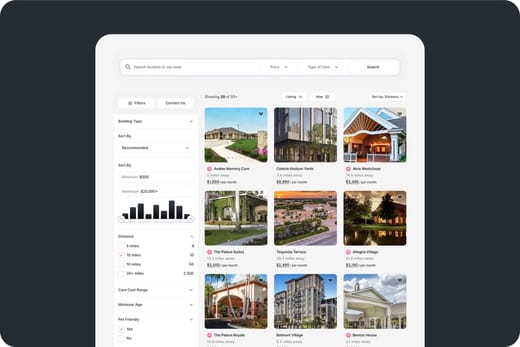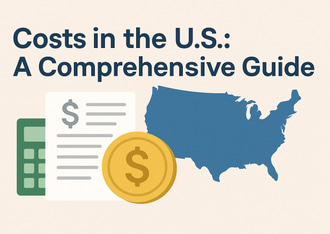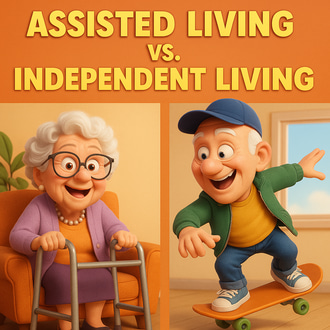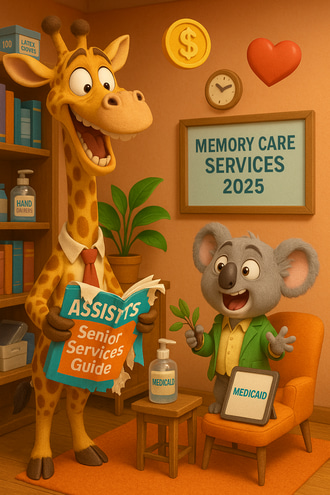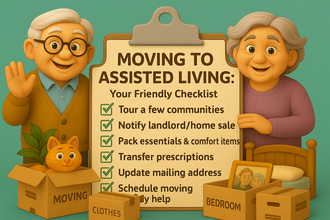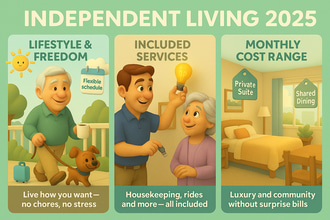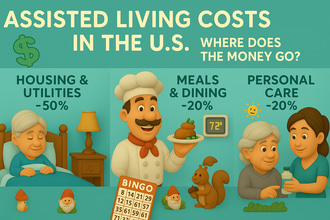Older adults who wish to stay with their furry companions in retirement can choose pet-friendly assisted living communities. Pet-friendly assisted living communities allow older adults to take their pets as they move into the community. This article explores the policies, costs, benefits, and considerations of pet-friendly assisted living, providing a guide for older adults and families for long-term care planning. Utilizing reputable sources like the Genworth Cost of Care Survey 2025, the National Center for Assisted Living (NCAL), A Place for Mom, and SeniorLiving.org, we provide a comprehensive guide on pet-friendly assisted living.
What Is Pet-Friendly Assisted Living?
Assisted living is a retirement option that provides older adults with assistance with ADLs, like bathing, grooming, and medication management, and conducts recreational activities. Pet-friendly assisted living, on the other hand, is an extension of these services, which allows older adults to bring pets, like dogs, cats, and birds, or have a community pet that interacts with residents. 86% of pet owners are found to have better mental health, which is crucial for preventing depression in old age, as reported by the American Psychiatric Association. Discover Village notes that 75% of senior living communities, assisted living included, welcome pets, while most communities offer pet-related services and therapy programs.
Key Features
1. Pet Policies
- Allowed Pets
- Communities usually allow dogs, cats, birds, fish, small caged animals like gerbils, and others allow pot-bellied pigs and tiny horses.
- Size and Weight Limits
- Usually 20 to 50 pounds. Senior Living Residences allows up to 50 pounds.
- Breed Restrictions
- Aggressive breeds may be restricted for safety purposes.
- Quantity
- Usually, one to two pets for each resident.
- Requirements
- Pets should be spayed or neutered, vaccinated, licensed, and well-behaved, with no history of biting or noise.
2. Pet Amenities and Services
- Outdoor Spaces
- Most pet-friendly communities have vast outdoor spaces or are set in proximity to parks, so pets can have a place to play around. Other communities, such as The Hacienda at the River in Arizona, provide animal-assisted programs with horses.
- Pet Care Support
- In most communities, residents are responsible for their pets, although limited assistance can be provided. Other communities like Silverado Beverly Place in LA offer full pet care for memory care residents.
- Pet Therapy
- Communities that offer pet therapy have community pets or visiting therapy animals that interact with residents to lift their moods.
- Social Activities
- Pet-related activities promote social interactions, like The Mann House’s Bow Wow Biscuits in Georgia, which encourages residents to make pet treats.
3. Living Spaces
- Pet-friendly assisted living communities often feature private apartments, which are suitable for small pets. Memory care units, on the other hand, tend to have smaller spaces, limiting pet suitability.
- Pet-free zones are also provided for residents with allergies.
Costs of Pet-Friendly Assisted Living
Pet-friendly assisted living has the same base cost as standard assisted living communities, however, additional fees are charged for pet-related matters.
- Base Cost
- National median – $5,676 monthly or $68,112 yearly
- Least expensive – Mississippi with $3,500 per month
- Most Expensive – Alaska with $7,250 per month
- Pet Fees
- Pet Deposit – One-time, refundable fee of $500 to $2,000 to cover possible damages, as noted by SeniorLiving.org.
- Monthly Pet Fee – A Place for Mom notes that most communities ask for $25 to $100 monthly per pet.
- Service Fees – Some communities may charge $50 to $300 for grooming and pet walking.
- Comparison
- Standard Assisted Living – average base cost is $5,676 monthly, but pet fees may increase total costs by up to 1 to 5%.
- Nursing Homes – Most nursing homes are not pet-friendly due to a medical focus, and they range from $9,197 to $10,326 per month.
- Memory Care – Pet owners with dementia have stricter pet rules, and the cost is around $7,500 to $10,000 monthly.
Funding Options
Additional fees for pets are not covered by Medicare, Medicaid, or Veterans Benefits. Some long-term care insurance may cover pet fees, though rare. Most pet fees are paid out of pocket.
Benefits
1. Mental Health
- According to the American Psychiatric Association, pets help reduce the risk of depression, anxiety, and loneliness, with 86% of owners reporting having better mental health. Additionally, AARP notes that 74% of older adults with pets feel a sense of purpose, which helps brighten their moods.
2. Physical Health
- The American Heart Association notes that walking pets promotes activity, which helps reduce cardiovascular risks. Moreover, pet interaction increases oxytocin and lessens stress hormones, lowering risks for depression and other mental health-related conditions, as per Harvard Heart Letter.
3. Social Engagement
- The Senior Services of America reported that pets promote social interactions, which helps prevent isolation.
4. Transition Support
- Having a familiar companion, even pets, fosters comfort and familiarity.
5. Cognitive Benefits
- Having a routine pet care may help slow the progression of dementia, especially for those with early-stage Alzheimer’s, as noted by SeniorAdvice.com
Considerations
1. Resident Responsibility
- Assisted Living Locators notes that in most communities, older adults should take care of their pets, providing another responsibility. As most care teams do not assume pet care duties, those with advanced cognitive conditions may not be eligible to bring their pets.
2. Pet Behavior
- Pet owners are responsible for their pets’ behavior; hence, pet-friendly communities provide assessments to ensure pets are calm and non-aggressive.
3. Facility Restrictions
- Pet-free zones are crucial in pet-friendly communities to cater to those with allergies and phobias, as reported by petfriendlyseniorliving.com
- Most memory care units allow visiting pets but restrict accommodating pets due to residents’ inability to care for them.
4. Pet Care Limitations
- SeniorLiving.org notes that pets with complex medical care may not be accommodated due to a lack of veterinary resources. Although other communities like The Mann House ensure quick access to pet needs with nearby pet clinics and vets.
5. Medicaid Facilities
- Medicaid-funded assisted living facilities, those that accept Medicaid waivers, rarely allow pets, due to budget constraints and accommodation requirements.
Special Considerations for Memory Care
Due to residents’ cognitive conditions, pet policies in memory care communities are stricter compared to those of assisted living communities.
- Restrictions – According to AgingCare.com, most memory care communities do not allow resident-owned pets but may accommodate visiting pets.
- Visiting Pets – To improve residents’ moods without having responsibilities, pets, like cats or dogs, are allowed to visit.
- Therapy Animals – May help relieve stress and agitation, especially in memory care communities.
- Exceptions – Some communities, like Silverado Beverly Place, provide pet support.
Questions to Ask When Choosing a Pet-Friendly Community
It is better to assess your needs and capabilities to find the right community. The following questions may help provide clarity for the community that best matches your needs, as suggested by SeniorGuidance.org and Next Avenue.
- Pet Policy: What types, sizes, breeds, and numbers of pets are allowed? Are there behavioral requirements?
- Fees: What are the pet deposit and monthly fees? Are there charges for pet services?
- Care Support: Does the facility offer dog walking, grooming, or emergency care? Who is responsible if the resident cannot care for the pet?
- Amenities: Are there dog runs, parks, or safe walking areas? Are pet-free zones designated?
- Pet Therapy: Are community pets or therapy programs available for non-pet owners?
- Space: Is the apartment suitable for the pet’s size and activity level?
- Veterinary Access: Are there nearby clinics or transport to vet appointments?
- Backup Plan: What happens to the pet if the resident is hospitalized or passes away?
Tips for a Smooth Transition
- Prepare Documentation – Prepare pet documents including vaccination records, licenses, and vet history, as noted by Caring.com
- Assess Pet Suitability – Most communities only allow small dogs or cats and low-maintenance pets.
- Introduce Gradually – Allow pets to adapt to new environments. If possible, bring familiar items.
- Engage in Activities – Join pet-related events to build community.
Conclusion
Pet-friendly assisted living has the same base cost as standard living in 2025; however, pet fees of $25 to $100 per month and $500 to $2,000 may be charged, depending on the community. Pets help reduce the risk of mental health-related conditions like depression and anxiety by promoting interactions and providing a sense of purpose. However, older adults and families must adhere to a pet-friendly community’s policies and assessments. Hence, it is better to plan and research communities that match their needs and preferences. Touring facilities and consulting advisors help ensure older adults and their pets find a community where they can adapt accordingly.

